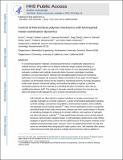Control of hierarchical polymer mechanics with bioinspired metal-coordination dynamics
Author(s)
Mozhdehi, Davoud; Cheng, Jing; Barrett, Devin G.; Guan, Zhibin; Messersmith, Phillip B.; Grindy, Scott Charles; Learsch, Robert W.; Holten-Andersen, Niels; ... Show more Show less
DownloadControl of hierarchical.pdf (1.104Mb)
OPEN_ACCESS_POLICY
Open Access Policy
Creative Commons Attribution-Noncommercial-Share Alike
Terms of use
Metadata
Show full item recordAbstract
In conventional polymer materials, mechanical performance is traditionally engineered via material structure, using motifs such as polymer molecular weight, polymer branching, or block copolymer design. Here, by means of a model system of 4-arm poly(ethylene glycol) hydrogels crosslinked with multiple, kinetically distinct dynamic metal-ligand coordinate complexes, we show that polymer materials with decoupled spatial structure and mechanical performance can be designed. By tuning the relative concentration of two types of metal-ligand crosslinks, we demonstrate control over the material's mechanical hierarchy of energy-dissipating modes under dynamic mechanical loading, and therefore the ability to engineer a priori the viscoelastic properties of these materials by controlling the types of crosslinks rather than by modifying the polymer itself. This strategy to decouple material mechanics from structure is general and may inform the design of soft materials for use in complex mechanical environments. Three examples that demonstrate this are provided.
Date issued
2015-08Department
Massachusetts Institute of Technology. Department of Materials Science and EngineeringJournal
Nature Materials
Publisher
Springer Nature
Citation
Grindy, Scott C. et al. “Control of Hierarchical Polymer Mechanics with Bioinspired Metal-Coordination Dynamics.” Nature Materials 14, 12 (August 2015): 1210–1216 © 2015 Macmillan Publishers Limited, Part of Springer Nature
Version: Author's final manuscript
ISSN
1476-1122
1476-4660